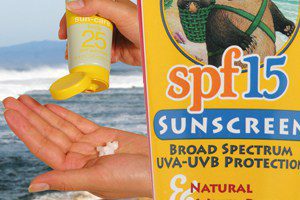
The U.S. Food and Drug Administration (FDA)’s final regulations on over-the-counter (OTC) sunscreens went into effect on June 18, 2012, establishing a standard test for which of these of these products could be labeled “Broad Spectrum.” To avert possible shortages of sunscreens during the summer months, FDA extended the compliance date until December 17, 2012. […]
 The U.S. Food and Drug Administration (FDA)’s final regulations on over-the-counter (OTC) sunscreens went into effect on June 18, 2012, establishing a standard test for which of these of these products could be labeled “Broad Spectrum.” To avert possible shortages of sunscreens during the summer months, FDA extended the compliance date until December 17, 2012.
The U.S. Food and Drug Administration (FDA)’s final regulations on over-the-counter (OTC) sunscreens went into effect on June 18, 2012, establishing a standard test for which of these of these products could be labeled “Broad Spectrum.” To avert possible shortages of sunscreens during the summer months, FDA extended the compliance date until December 17, 2012.
Under the new regulations, sunscreen products that protect against all types of sun-induced skin damage will be labeled “Broad Spectrum” and “SPF 15” (or higher) on the front. Broad spectrum products protect against both UVA (ultraviolet A) and UVB (ultraviolet B) radiation. While UVB is the primary cause of sunburn, both UVA and UVB cause sunburn, skin cancer, and premature skin aging. In broad spectrum sunscreens, the higher the SPF (Sun Protection Factor), the greater the level of overall protection.
Any sunscreen not labeled as Broad Spectrum or that has an SPF between 2 and 14, has only been shown to help prevent sunburn.FDA has been developing sunscreen testing and labeling requirements for decades, said Reynold Tan, a scientist with FDA’s Division of Nonprescription Regulation Development, but only recently have data become sufficient for the division to establish a reliable test for broad spectrum UV protection.
Consumers will find additional help in choosing the best sunscreen for their needs in additional labeling provisions that cover issues like water resistance, length of protection between applications, and claims that a product is effective immediately on application (“instant protection”).
Sunscreen products that are not broad spectrum or that are broad spectrum with SPF values from 2 to14 will be labeled with a warning of their lesser effectiveness in protecting against sunburn, skin cancer, and premature skin aging.
CosmeticsDesign.com USA notes, however, that the FDA has yet to issue its promised monograph on OTC sunscreens. Product forms included in the monograph can be marketed without individual approval while those not included—sprays, wipes, and towelettes are current examples—cannot be marketed as sunscreens without an approved application. ConsumerDesigns.com USA further notes that public interest and consumer groups are concerned that the FDA has not yet addressed health and environmental issues relating to nanoscale ingredients used in sunscreens to optimize the performance of other ingredients.


